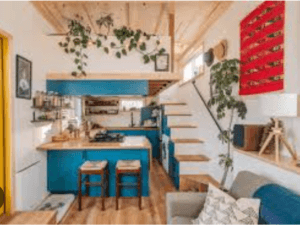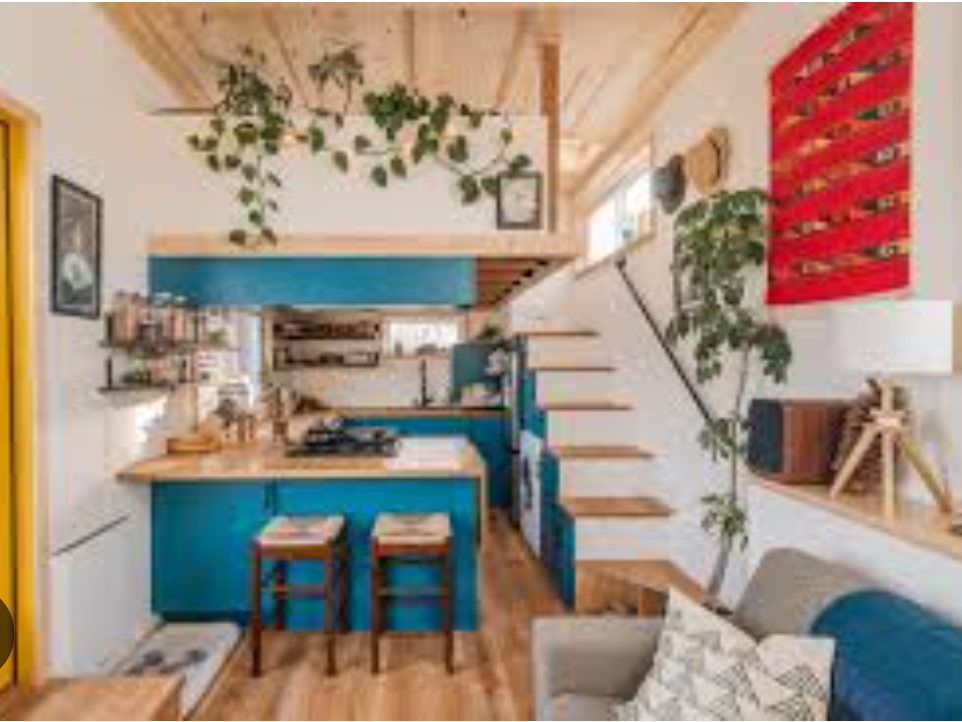
When it comes to designing a kitchen for your tiny home, every inch counts. You’re going to want a space that’s not just compact, but also highly functional. This means thinking strategically about the layout. I’m going to guide you through the process of creating a kitchen that packs a punch in efficiency while making the most of the limited space you have.
The first step is to consider the layout; it’s the backbone of your kitchen’s functionality. Opting for an L-shaped or galley kitchen can save space while maintaining a good workflow. Next, let’s talk about appliances. You’ll want to look for multi-functional and compact options—think of a two-burner stove that doubles as counter space or a mini dishwasher tucked under the sink.
Vertical storage solutions are your best friend in a tiny kitchen. Go for tall, narrow cabinets; add shelves above the windows or retractable hooks for hanging items. Don’t overlook hidden spaces, like toe-kick drawers and narrow pull-out cabinets for spices and utensils. Lighting is crucial too; under-cabinet lights or a skylight can not only make the kitchen tasks easier but also give the illusion of more space. And remember, lighter colors for cabinetry and walls can help the room feel larger.
Executing these space-saving strategies sets a solid foundation for a kitchen that is a pleasure to cook in, despite its size. But don’t forget that it’s not just about how many pots and pans you can fit. Comfort and style play an enormous role in making your tiny home kitchen a space you love. That’s what the next section focuses on: the balance between ergonomics, aesthetics, and practicality in your kitchen design.
Ergonomics and Aesthetics: A Balanced Approach
Now that we’ve tackled maximizing space, let’s focus on marrying ergonomics with aesthetics. It’s not just about making your tiny home kitchen look good, it’s also about creating a space that’s a joy to use.
Ergonomic design is crucial in a small kitchen. You’ll want to define work zones based on the classic kitchen triangle concept, ensuring that the fridge, sink, and stove are within easy reach of each other. This setup saves time and effort, making meal prep smoother and more enjoyable.
When choosing furnishings and fixtures, your goal should be to find items that are both user-friendly and visually appealing. Think chairs that tuck away neatly, faucitable with swivel spouts, and storage that slides out for easy access.
Regarding style, the aesthetics of your tiny kitchen should reflect your personality while remaining functional. Opt for a clean and modern look, or a cozy and rustic vibe � the choice is yours. The use of glass or reflective materials can also give the illusion of a larger space while contributing to the overall style.
And let’s not forget about keeping your kitchen clutter-free. It’s essential for maintaining both the look and the ease of movement in your tiny home kitchen. Regularly declutter, invest in organizers that suit your space, and be disciplined about what you bring into your kitchen.
Stick around, because in the next section, we’re going to explore sustainable practices in tiny kitchen design that will not only benefit the environment but also your well-being and potentially your wallet too.
Sustainable Practices in Tiny Kitchen Design
When it comes to tiny homes, choosing sustainable options is not just a trend, it’s a way of living. In your compact kitchen, every choice you make has a direct impact on the environment. That’s why incorporating eco-friendly kitchen appliances is a big deal. I’m talking about energy-efficient fridges, stoves, and ovens that not only reduce your carbon footprint but can also help you save on utility bills in the long run.
But sustainability doesn’t stop at your appliances. The materials and finishes you choose play a significant role, too. I’d encourage you to opt for materials that are not only durable and long-lasting but also harvested or manufactured responsibly. Think bamboo flooring, recycled glass countertops, and cabinetry finished with low-VOC paints and stains. These choices aren’t just good for the planet; they help maintain a healthier indoor air quality for you and your family.
Now, imagine having fresh herbs right at your fingertips. Adding a mini herb garden or a green wall doesn’t just bring a pop of color and life to your tiny kitchen; it’s also super practical. You’ll be able to enjoy organic, homegrown flavors anytime, and you’re going to love the additional air purification it offers.
Advancements in kitchen technology are also paving the way for greener living. Energy monitoring systems help track your electricity usage, while innovative composting solutions can integrate seamlessly into your tiny space. Remember, in a small home, smart tech choices can make a world of difference.
Lastly, let’s talk trash – or rather, how to manage it effectively in a tiny kitchen. Waste management is key to maintaining sustainability, so integrating multi-stream recycle bins and a compact compost bin can dramatically cut down waste heading to the landfill. Choose systems that are easy to use and clean, because the easier it is, the more likely you’ll stick to a routine that’s better for our planet.
It all circles back to making intentional, informed choices that benefit you and the environment. By designing a kitchen that embraces sustainability, you’re not just crafting a space that’s good for cooking, but one that’s mindful of its footprint on the world. That’s the kind of kitchen that feels just right in a tiny home, don’t you think?


It is interesting to know how so many people take an interest in large kitchens including myself but the flip side of the coin is small kitchens are also making a mark and have caught the attention of many it seems. A small kitchen can become functional. It all depends on what you want and then going and creating that type of kitchen that fits your needs. Thanks for sharing.
Hello Carmen,
I just had the pleasure of diving into your post on designing a functional kitchen for tiny homes, and I must say, it’s packed with insightful tips and innovative ideas! I also appreciate your focus on the ergonomic aspect of kitchen design. It’s clear that ensuring the kitchen triangle is optimized not only enhances the cooking experience but also preserves the joy and ease of meal preparation. This, coupled with your thoughtful choice of furnishings that are both aesthetically pleasing and practical, truly caters to the needs of tiny home dwellers.
Thank you for such a thorough guide on designing a functional and sustainable kitchen in a tiny home. You’ve put a lot of thought and expertise into this, making it a valuable resource for anyone looking to optimize their small living space without sacrificing comfort or style.
Eric
Thank you for taking the time to visit our website. Your feedback and comments are greatly apprecieated as it allows us to continue and perfect our work to the best of our abilities.